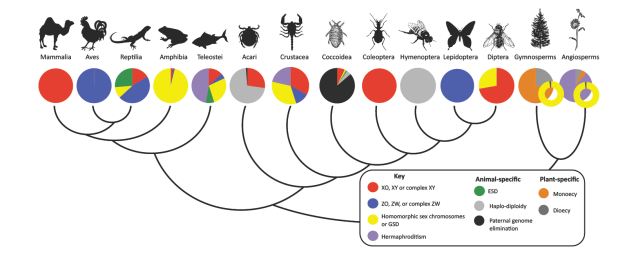Sex, and not the natural kind.
Here's a pretty old post from the blog archives of Geekery Today; it was written about 11 years ago, in 2014, on the World Wide Web.
Here’s a story from last month over at Science Made Easy, featuring a nice diagram which is (misleadingly, in my view) called the Tree of Sex.
What makes a creature male or a female? If you mentioned the X and the Y chromosomes, you are correct. I mean, you’re correct if you ignore most forms of life on this planet. If you actually take the time to examine the lifestyles of different life forms, many of the basic assumptions about sex differences don’t hold.
I am going to try and explain this to you, using the Tree of Sex. This family tree traces the ancestry of sex in all of its weird and wonderful manifestations. Those Pie charts are coded according to the method of sex, and I will be explaining what each of those colour codes mean below.
. . .
–Faz Alam, What can we learn from the Tree of Sex?
Science Made Easy (3 June 2014).
You should read the whole article, because if you’re not familiar with this stuff, it’s pretty interesting from a scientific standpoint.
That said, I think that the main thing that this kind of diagram shows is that really it’s kind of a silly and obsolete bit of cultural detritus that we go on pretending that bees and mayflies and fig trees even have male
and female
sexes that way that humans or turkeys (kind of, somewhat) have male
and female
sexes. They have sexual reproduction, sure, but when it comes to the idea of the sexes
of individual organisms, what we’re talking about across all these different species are basically very different biological phenomena. They’re basically very different in what they arise from, structurally, and they’re also basically very different in how they function. Trying to wrap them up with human categories for sexual dimorphism[1] is at this point kind of like imagining that the queen
of an anthill goes around wearing a little crown and ordering ant commoners to do her bidding. Biological
sex is not a natural kind, it is the projection of a social metaphor, and often it’s kind of a misleading or an unhelpful one.
- [1]Actually, spoiler alert, biological sex is actually also really complicated in human beings and the binary social categories don’t line up all that perfectly with the diversity of actual human bodies.↩

Reply to Sex, and not the natural kind. Follow replies to this article · TrackBack URI
Follow replies to this article · TrackBack URI